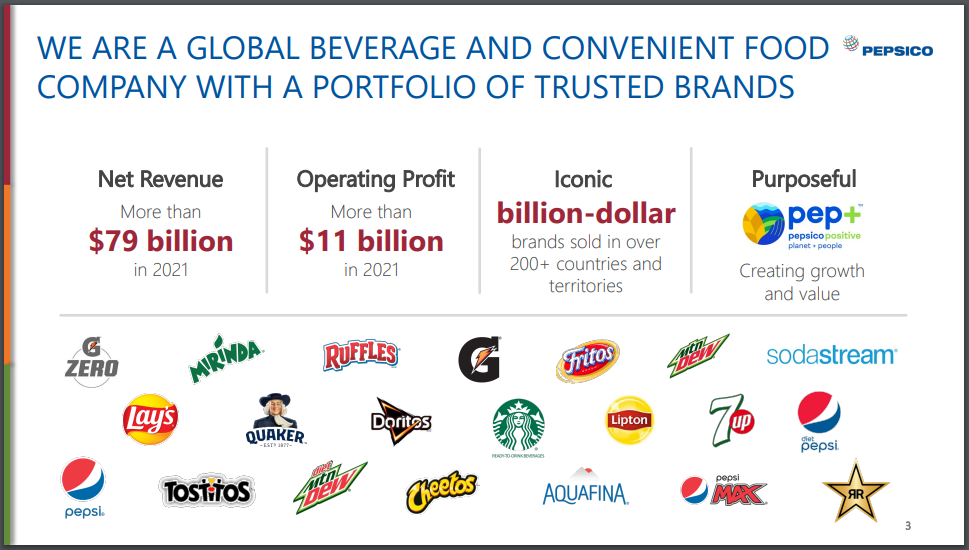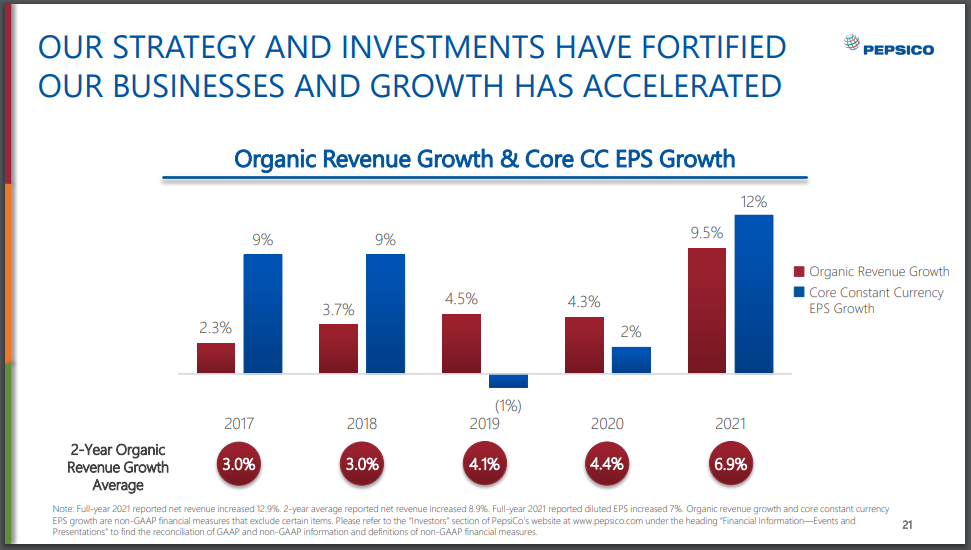First Published on February 5th, 2023 by Quinn Mohammed for SureDividend
As the saying goes, slow and steady wins the race. This phrase comes to mind when reviewing the Dividend Aristocrats, a select group of 68 companies in the S&P 500 Index, with 25+ consecutive years of dividend increases.
We believe the Dividend Aristocrats are the “cream of the crop” of the U.S. stock market. With this in mind, we created a list of all 68 Dividend Aristocrats, along with important financial metrics such as dividend yields and price-to-earnings ratios.
You can download your free list of all 68 Dividend Aristocrats by clicking on the link below:

We review all the Dividend Aristocrats each year. Next up, we will review the food and beverage behemoth PepsiCo (PEP).
The stock offers a solid 2.7% dividend yield and has increased its dividend for 50 years in a row. The company’s dividend is very safe, and the stock is suitable for risk-averse income investors.
PepsiCo’s valuation is not a screaming bargain right now, but it is rarely a cheap stock due to its robust business model and steady growth. The company should have little trouble continuing to raise its dividend for many years.
Business Overview
Pepsi-Cola was created in the late 1890s by Caleb Bradham, a North Carolina pharmacist. Meanwhile, Frito-Lay, Inc. was formed in 1961 from the merger of Frito Company and the H. W. Lay Company. In its current form, PepsiCo came together as a result of the 1965 merger of Pepsi-Cola and Frito-Lay.
Today, PepsiCo is a global food and beverage giant. It has a market capitalization of $236 billion and generates nearly $80 billion of annual revenue.

Its business is nearly equally split between its food and beverage segments. It is also balanced geographically between the U.S. and the rest of the world.
PepsiCo has a large portfolio and owns many popular brands. Some of the company’s major brands include Pepsi and Mountain Dew sodas and non-sparkling beverages like Pure Leaf, Tropicana, Gatorade, and bottled water.
In addition to PepsiCo’s core beverage brands, it also has a large snacks business under the Frito-Lay brand. The company has also built a portfolio of healthier foods, including Quaker, Naked, and Sabra. Its diverse portfolio has served the company well. It has products that cater to all tastes across the health spectrum.
PepsiCo reported results for the third quarter on October 12th, 2022. Revenue increased 8.8% year-over-year to nearly $22 billion, surpassing expectations by $1.15 billion.
Adjusted earnings-per-share equaled $1.97 and was a 10% increase from the same prior year period. Year-to-date, revenue grew 7.7% to $58.4 billion. Meanwhile, adjusted EPS of $5.12 was 11% higher than the prior year.
Unit volumes for food and snack fell by 1.5%. Beverage volume rose by 3%. Revenue for PepsiCo Beverages North America improved by 13%, with a 7% increase in volumes. Frito-Lay North America’s revenue grew 20% even though volumes were down by 2%. And Quaker Foods North America’s revenue was up 16%, with a 4% volume decrease.
PepsiCo revised its 2022 outlook, and the company now expects adjusted earnings-per-share of $6.73 for the entire year.
Growth Prospects
PepsiCo has a long history of steady growth. Even in a challenging environment for soda, PepsiCo has continued its consistent growth.
An illustration of the company’s performance from 2017 can be seen in the below image.

We believe PepsiCo will generate around 5%-6% adjusted earnings-per-share growth per year over the next five years. Going forward, two of PepsiCo’s most promising catalysts are growth in healthier foods and beverages and emerging markets.
Soda sales are slowing down in developed markets like the U.S., where soda consumption has declined for over a decade.
As a result, large soda companies like PepsiCo have had to adapt to a more health-conscious consumer. To do this, PepsiCo has shifted its portfolio toward healthier foods that are resonating more strongly with changing consumer preferences.
In addition, PepsiCo has a huge growth opportunity in emerging markets like China, Africa, India, and Latin America. These are under-developed regions of the world with large consumer populations and high economic growth rates.
Emerging markets were a growth driver once again last quarter. Revenue for the Africa/Middle East/South Asia was up 17%, primarily due to volume growth and beverage strength.
Latin America revenue increased by 22%, and the Asia Pacific/Australia/New Zealand/China region increased by 8%, along with a 7% and 9% improvement in beverage volume, respectively.
Competitive Advantages & Recession Performance
PepsiCo has numerous competitive advantages. Among them are strong brands and a global scale. In all, PepsiCo has 23 individual brands that each collect at least $1 billion in annual revenue. Strong brands give PepsiCo optimal shelf space at retailers and give the company pricing power.
PepsiCo’s financial strength also allows the company to invest in research and development and advertising to retain its competitive advantages.
For example, PepsiCo invests billions each year in research and development to innovate new products and packaging designs. In addition, PepsiCo regularly spends more than $2 billion each year on advertising to maintain market share and build brand equity with consumers.
PepsiCo’s competitive advantages and strong brands make the company highly profitable, even during recessions. Food and beverages always retain a certain level of demand, which is why the company held up so well during the Great Recession.
PepsiCo’s earnings-per-share throughout the Great Recession of 2007-2009 are listed below:
- •2007 earnings-per-share of $3.34
- •2008 earnings-per-share of $3.21 (3.9% decline)
- •2009 earnings-per-share of $3.77 (17% increase)
- •2010 earnings-per-share of $3.91 (3.7% increase)
As you can see, PepsiCo’s earnings-per-share declined only modestly in 2008. The company proceeded to grow earnings by nearly 20% in 2009, which is very impressive. Earnings continued to grow once the recession ended.
The company reported strong growth in 2020 and 2021 when the coronavirus pandemic sent the U.S. economy into a recession. Therefore, PepsiCo is a recession-resistant business.
Valuation & Expected Returns
PepsiCo is expected to generate earnings-per-share of $6.73 for 2022. Based on this, the stock trades for a price-to-earnings ratio of 25.1. Our fair value estimate is a price-to-earnings ratio of 21.0. Thus, the stock appears overvalued. A declining price-to-earnings ratio could reduce annual returns by 3.6% each year over the next five years.
As a result, future returns will likely be comprised of earnings-per-share growth and dividends. We expect PepsiCo to grow earnings-per-share each year by 5.5%, consisting of organic revenue growth, acquisitions, and share repurchases.
In addition, PepsiCo also has a 2.7% current dividend yield. Still, the overvaluation will be difficult for the stock to overcome. The combination of valuation changes, earnings growth, and dividends results in total expected returns of 4.6% per year over the next five years.
PepsiCo has a secure dividend, with a projected dividend payout ratio of about 68% for 2022. This gives PepsiCo enough room to continue increasing the dividend at a rate in-line with the growth rate of its adjusted EPS.
Shares do trade with a premium valuation, but that is likely due to the company’s strong growth. Few other companies in the consumer staples sector can match its growth.
Even fewer companies can match PepsiCo’s history of dividend growth. PepsiCo recently achieved Dividend King status in February 2022. As such, we continue to rate shares as a hold.
Final Thoughts
PepsiCo is a very strong business with a number of category-leading brands. Investing heavily in new products and acquisitions will likely continue growing sales and earnings for many years.
Shareholders should continue to benefit from PepsiCo’s strong business through annual dividend increases. The stock is overvalued, which means value investors should wait for a more attractive entry point before buying shares.
That said, PepsiCo remains a valuable holding for a dividend growth portfolio.
This article was first published by Quinn Mohammed for Sure Dividend
Sure dividend helps individual investors build high-quality dividend growth portfolios for the long run. The goal is financial freedom through an investment portfolio that pays rising dividend income over time. To this end, Sure Dividend provides a great deal of free information.
Related:




